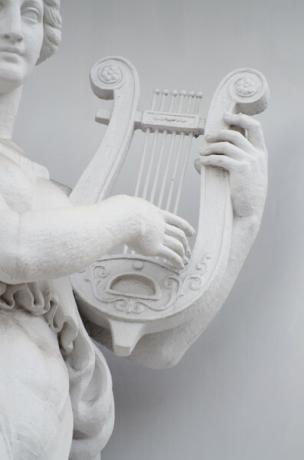Symbolism in Brazil begins with the publication of the work Missal and Brockets de Cruz e Souza in 1893. In addition to being a precursor of the movement, he was certainly one of the most emblematic writers of the period, alongside Alphonsus de Guimarães.
Cruz e Souza

Cruz e Souza (1861-1898) was the son of slaves and can be considered the most important poet of Symbolism in Brazil. Born in Florianópolis, Santa Catarina, he had his studies sponsored by a family of aristocrats. He worked in the Santa Catarina press, where he wrote abolitionist articles.
He moved in 1980 to Rio de Janeiro, where he worked in various segments. While still young, he fell in love with a white artist, but was married to a black woman. Cruz e Souza and Gavita had four children, two of whom died and the woman had mental problems.
He died of tuberculosis at age 36 and his only published works are Missal (prose) and Buckles (verse). His literary production is marked by the abandonment of subjectivism and anguish because there is a search for universal positions.
In principle, his first works report on the pain and suffering of the black man, with a clear evolution towards the analysis of the pain and suffering of man in general.
Characteristics of Cruz e Souza's Poetry:
- Sublimation
- Annulment of matter for freedom from spirituality (death)
- Appreciation of Platonic ideas
- sexual anguish
- Obsession with the color white and with everything that might suggest whiteness
- sensory appeals
- Symbols, games and vowels
- Musicality
- Alliteration
guitars that play
Ah! Weeping, lukewarm, dormant guitars,
Sobbing in the moonlight, crying in the wind...
Sad profiles, the vaguest outlines,
Mouths muttering with regret.
Nights beyond, remote, that I remember,
Lonely nights, remote nights
That in the blues the Fantasia board,
I go on constellation of unknown visions.
When the sounds of the guitars are sobbing,
When the sounds of guitars on the strings moan,
And they go on tearing and delighting,
Tearing the souls that tremble in the leftovers.
Harmonious that puncture, that lacer,
Nervous and agile fingers that run
Strings and a world of ailments generate
Moans, cries, who die in space...
And dark sounds, sighed sorrows,
Bitter sorrows and melancholies,
In the monotonous whisper of the waters,
Nightly, between cold branches.
Veiled voices, velvety voices,
Volupts of guitars, veiled voices,
wander in the old fast vortexes
From the winds, alive, vain, vulcanized.
Everything on the guitar strings echoes
And it vibrates and writhes in the air, convulsing...
Everything in the night, everything cries and flies
Under the feverish flutter of a pulse.
That these foggy and dreary guitars
They are islands of atrocious, funereal exile,
Where they go, tired of dreams,
Souls that were immersed in mystery.
Alphonsus de Guimaraens

Alphonsus de Guimaraens (1870-1921) was born in Ouro Preto, Minas Gerais. He was a law student and after finishing his studies, he served as a judge of law in Mariana. He also studied Social Sciences in São Paulo and completed the course in 1895.
He married Zenaide de Oliveira and with her they had 14 children. It was in the city of Rio de Janeiro that he met Cruz e Souza, becoming friends with the poet.
His poetry is marked by the posture of devotion and mysticism and, above all, the death of Constança, the cousin he loved and who died at 17 years old. Thus, Constança appears in all themes: religion, art and nature.
Their religiosity and devotion are considered exaggerations amidst spiritualized love. He produced for about 30 years in a work of Renaissance and Arcadian influence. She is adept at the decasyllable verse, but came to explore the larger round.
Characteristics of Alphonsus Poetry from Guimaraens:
- Mysticism
- Love
- Death
- Sublimation through death
- suggestion language
- Alliteration
- Tendency to self-compassion
Ismalia
When Ismalia went crazy,
she stood in the tower dreaming...
He saw a moon in the sky,
he saw another moon on the sea.
In the dream he got lost in,
bathed in moonlight...
He wanted to go up to heaven,
I wanted to go down to the sea...
And, in his madness,
in the tower he began to sing...
It was close to heaven,
it was far from the sea...
And like an angel hung
the wings to fly...
I wanted the moon in the sky,
I wanted the moon from the sea...
the wings that God gave you
roared from pair to pair...
His soul rose to heaven,
his body went down to the sea...
Symbolism
The movement that became known as Symbolism emerged at the end of the 19th century in France. It represented the artistic reaction to the wave of materialism and scientism marked in Europe.
He rejected the so-called rationalist, mechanical and empirical solutions, revealed in the science of the time. The authors of this period sought to rescue the interaction between man and the sacred.
Symbolism is marked by subjectivism, vague, fluid language, anti-materialism, sonnet and a resumption of the romantic tradition.
Read too:
- Symbolist Poetry
- The Language of Symbolism
- Characteristics of Symbolism
- Symbolism in Brazil
- symbolism in Portugal
- Symbolism: characteristics and historical context
- Questions about Symbolism

